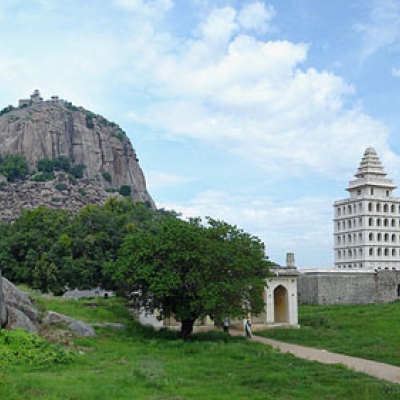
Gingee
Located on three hills this Fort is a remarkable example of military engineering. The site of the extensive Fort complex is set in a serene peaceful landscape. The scenery here is quite dramatic and the location has often been used in films. Constructed on three separate hills with a fortified wall extending for 5km the ruined structure has special charm.
The wall is 15 metres thick in some places and inside the complex are a Shiva Temple, a Mosque, and the prominent Kalyana Mahal. The Kalyana Mahal contains a pagoda like structure which was used for wedding ceremonies.
A visitor could easily spend a day exploring this location in detail.Originally the site of a small fort built by the Chola dynasty in 9th century AD, it was later modified by the Vijayanagar Empirein the 13th century to elevate it to the status of an impenetrable citadel to protect the small town of Gingee.
It was also the head quarters of the Gingee Nayaks, during the Nayak domination in Tamil Nadu. The fort was built as a strategic place for fending off any invading army. The fort was further strengthened by the Marathas under the leadership of Shivaji in 1677 AD. He recaptured it from the Bijapur sultans who had originally overthrown the Marathas.
During Aurangzeb's campaign in the Deccan, Shivaji's second son who had assumed the throne, Chhatrapati Rajaram escaped to Gingee in the distant South and continued the fight with Moghuls from Gingee. The Moghuls could not capture the fort for seven years in spite of laying siege.
The fort was finally captured in 1698, but not before Chhatrapati Rajaram escaped. It was later passed on to the Carnatic Nawabs who lost it to the French in 1750 before the British finally took control in 1761 despite losing it to Hyder Ali for a brief period.